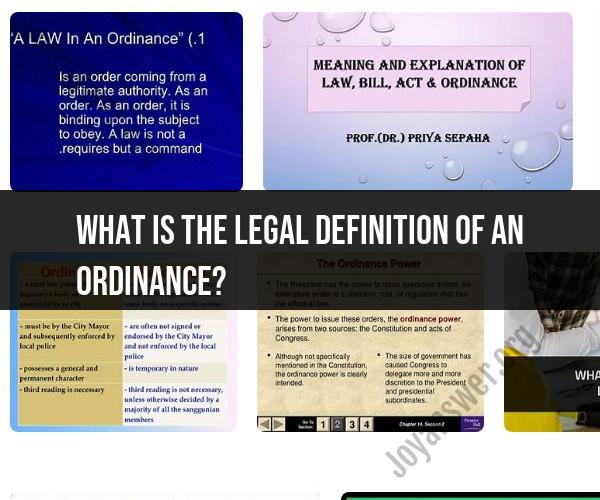What is the legal definition of an ordinance?
An ordinance is a type of legislation, typically at the local level, that is enacted by a municipal or county government. The legal definition of an ordinance can vary from one jurisdiction to another, but in general, it is a law, rule, or regulation that has the force of law within the geographic boundaries of the local government that passes it. Here's a broad legal definition:
Ordinance: An ordinance is a local law, rule, or regulation adopted by a city, town, county, or other local government authority, usually pursuant to the authority granted to them by state or federal law. It is a binding legal measure that governs various aspects of local affairs, such as land use, zoning, public health, safety, sanitation, taxation, and other municipal concerns.
Key characteristics of ordinances include:
Local Jurisdiction: Ordinances are specific to a particular local government or municipality and apply only within its geographical boundaries. They do not have extraterritorial effect.
Legislative Process: Ordinances are typically enacted through a formal legislative process, which often involves multiple readings, public hearings, and approval by the local governing body, such as a city council or county board.
Enforcement: Ordinances are enforced by local law enforcement agencies or other relevant local authorities. Violations of ordinances can result in penalties or fines.
Specific Topics: Ordinances can cover a wide range of topics, including building codes, zoning regulations, noise control, traffic regulations, business licensing, and more. They are designed to address local issues and concerns.
Consistency with State and Federal Law: Ordinances must be consistent with state and federal law. Local governments do not have the authority to pass ordinances that conflict with higher levels of government.
Amendment and Repeal: Local governments can amend or repeal ordinances as needed to address changing circumstances or priorities.
It's important to note that the specific requirements and procedures for enacting ordinances can vary between jurisdictions. Therefore, individuals and businesses should consult the local government's website or contact municipal officials to understand the ordinances applicable to their area and ensure compliance with local laws.
Understanding the Legal Definition of an Ordinance
An ordinance is a law enacted by a local government, such as a city, county, or town. Ordinances are typically more specific and limited in scope than state or federal laws. They are used to address matters of local concern, such as zoning, noise pollution, and public safety.
The Purpose and Scope of Local Ordinances
The purpose of local ordinances is to promote the health, safety, and welfare of the community. Ordinances can cover a wide range of topics, including:
- Zoning and land use
- Building codes
- Noise pollution
- Public safety
- Public morals
- Environmental protection
- Business regulations
- Animal control
- Traffic and parking
How Ordinances Are Created and Enforced
The process for creating and enforcing ordinances varies from state to state. However, there are some general steps that are typically followed:
- The local government body (e.g., city council or county board of supervisors) introduces an ordinance.
- The ordinance is published in a local newspaper or on the government's website.
- A public hearing is held to allow residents to comment on the proposed ordinance.
- The local government body votes on whether to adopt the ordinance.
- If the ordinance is adopted, it is published again and takes effect on a certain date.
Ordinances are enforced by local law enforcement agencies, such as the police department or sheriff's office. Violations of ordinances can result in fines, jail time, or both.
Examples of Common Municipal Ordinances
Some examples of common municipal ordinances include:
- Zoning ordinances: These ordinances regulate how land can be used, such as for residential, commercial, or industrial purposes.
- Building codes: These ordinances establish minimum safety standards for the construction and maintenance of buildings.
- Noise pollution ordinances: These ordinances restrict noise levels in certain areas, such as residential neighborhoods and near schools.
- Public safety ordinances: These ordinances prohibit activities that could pose a danger to public safety, such as setting fires or discharging fireworks.
- Public morals ordinances: These ordinances prohibit activities that are considered to be morally offensive, such as public nudity and prostitution.
- Environmental protection ordinances: These ordinances regulate activities that could harm the environment, such as pollution control and water conservation.
- Business regulations: These ordinances regulate the operation of businesses in the community, such as licensing requirements and signage restrictions.
- Animal control ordinances: These ordinances regulate the ownership and care of animals, such as leash laws and pet licensing requirements.
- Traffic and parking ordinances: These ordinances regulate traffic and parking in the community, such as speed limits and parking restrictions.
The Impact of Ordinances on Communities
Ordinances can have a significant impact on communities. They can help to improve public safety, protect the environment, and promote economic development. For example, zoning ordinances can help to ensure that businesses and industries are located in appropriate areas. Building codes can help to ensure that buildings are safe and up to code. And noise pollution ordinances can help to reduce noise levels and improve the quality of life for residents.
However, ordinances can also have negative impacts on communities. For example, overly restrictive zoning ordinances can stifle economic development. And overly punitive ordinances can disproportionately impact marginalized groups.
It is important for local governments to carefully consider the potential impacts of ordinances before enacting them. Ordinances should be designed to promote the public good, not to restrict individual freedoms or harm certain groups of people.












